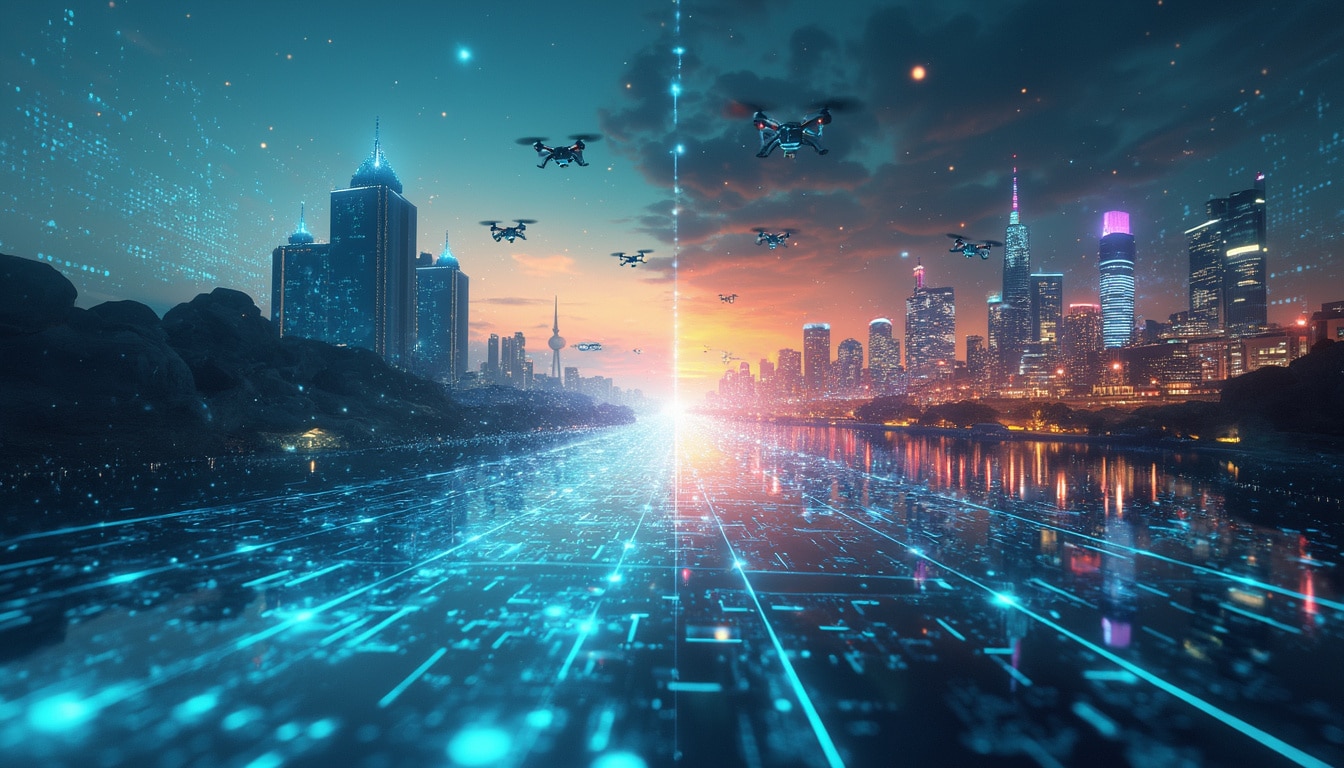Have you ever wondered what our oceans would look like if superheroes were real?
Well, meet the SeaClear robots – the unsung heroes of the deep blue!
Armed with artificial intelligence and a knack for tidying up, they’re on a mission to declutter our seas.
Gone are the days when ocean cleanup was a daunting task for human divers alone. The SeaClear project, an innovative initiative by a leading EU research firm, has unleashed a fleet of automated robots designed to tackle plastic waste from the ocean floor. This high-tech ensemble includes a boat, a drone, two specialized robots, and a sturdy basket, all working in perfect harmony. Utilizing AI-powered mapping, these robots meticulously chart the seabed, identify litter, and collect it with impressive efficiency. Currently capable of lifting up to 7 kilograms and operating in waters tens of meters deep, the SeaClear system is a game-changer in marine conservation. With the upcoming SeaClear2.0, the team aims to enhance their robotic squad to handle even greater challenges, bringing us one step closer to cleaner, healthier oceans.

Table of contents
Toggleintroducing seaclear: revolutionizing ocean cleanup with robotics
The SeaClear project is making significant waves in the realm of ocean conservation through its innovative use of autonomous robots. Spearheaded by a consortium of European researchers and industry experts, SeaClear is dedicated to combating the pervasive issue of marine litter. By deploying a fleet of unmanned underwater, surface, and aerial vehicles (UUV, USV, UAV), the project aims to efficiently locate and remove plastic waste from both the ocean floor and the water column. This multifaceted approach not only enhances the effectiveness of cleanup operations but also ensures that efforts are concentrated in coastal areas, where the accumulation of debris is most pronounced.
how do seaclear’s robots navigate the deep blue?
At the heart of the SeaClear system lies a sophisticated integration of hardware and software designed to operate seamlessly in challenging underwater environments. The system comprises a boat, a drone, two specialized robots, and a collection basket. Together, these components create a comprehensive mapping of the ocean floor, pinpointing areas laden with plastic waste. Utilizing advanced artificial intelligence, the robots are capable of detecting, classifying, and collecting debris with remarkable precision. Currently, each robot can lift up to 7 kg and is equipped with a gripper designed to handle the volume of two 2L soda bottles, making them highly efficient in gathering litter from depths reaching tens of meters.
what makes seaclear’s technology stand out?
SeaClear’s innovative edge lies in its ability to combine multiple robotic platforms to tackle marine pollution effectively. The integration of machine learning algorithms allows the robots to differentiate between various types of litter, ensuring that the cleanup process is both targeted and efficient. The project’s SeaClear2.0 iteration represents a significant advancement, with the robots now capable of operating at depths of up to 100 meters and lifting items weighing as much as 250 kilograms. This enhancement not only broadens the scope of their operations but also substantially increases the volume of debris that can be removed in a single mission.
what are the environmental benefits of seaclear?
The environmental impact of SeaClear’s robotic cleanup efforts is profound. By effectively removing plastic waste from the ocean, SeaClear helps to mitigate the detrimental effects of marine pollution on marine life and ecosystems. Plastic debris poses a significant threat to a wide array of marine organisms, from the tiniest plankton to the largest whales. By targeting and removing this waste, SeaClear contributes to the restoration of healthy marine habitats and supports biodiversity. Additionally, the project’s focus on coastal regions ensures that cleanup efforts are concentrated where they are needed most, providing immediate benefits to both the environment and local communities reliant on these ecosystems.
how is seaclear funded and supported?
The SeaClear project is a testament to the power of collaborative research and innovation, receiving substantial funding from the European Union’s Horizon 2020 research and innovation program. This financial backing has been instrumental in advancing the project from concept to reality, allowing researchers to develop and refine the robotic systems necessary for effective ocean cleanup. The consortium behind SeaClear includes leading institutions and industry partners from five different countries, ensuring a diverse range of expertise and perspectives. This collaborative approach not only accelerates technological advancements but also fosters a shared commitment to addressing the global challenge of marine pollution.
what challenges does seaclear face in ocean cleanup?
Despite its groundbreaking approach, the SeaClear project encounters several challenges inherent to underwater operations. Navigating the complexities of marine environments, such as varying depths, currents, and the presence of diverse marine life, requires robust and adaptable robotics. Ensuring the energy efficiency of the robots is crucial for prolonged missions, particularly in deep waters where recharging can be impractical. Additionally, the detection and classification of litter amidst the natural seabed terrain demand highly accurate machine learning models. Overcoming these obstacles is essential for maximizing the effectiveness of SeaClear’s cleanup missions and ensuring the sustainability of its operations.
what is the future outlook for seaclear and robotic ocean cleanup?
The future of SeaClear is bright, with ongoing developments poised to enhance its capabilities and expand its reach. The next iterations of the project aim to incorporate more advanced robotic technologies, including enhanced sensors for better detection and more efficient collection mechanisms. Plans are also underway to develop a larger fleet of robots, enabling simultaneous operations in multiple areas and increasing the overall impact of cleanup efforts. Beyond technological advancements, SeaClear is exploring partnerships with other environmental initiatives to create a more integrated approach to marine conservation. As robotics continue to evolve, SeaClear stands at the forefront of a movement to restore our oceans and safeguard them for future generations.
how does seaclear compare to other robotic innovations?
SeaClear distinguishes itself in the competitive landscape of robotic innovations by its specific focus on marine litter collection. While many robotic projects explore diverse applications, SeaClear’s specialized approach allows for targeted improvements and optimizations tailored to underwater environments. This focus is complemented by the project’s comprehensive use of UUV, USV, and UAV platforms, creating a versatile and robust system capable of addressing multiple facets of ocean pollution. In comparison to other initiatives like the Chinese Unitree robots, which revolutionize accessibility and general innovation, SeaClear remains uniquely committed to environmental restoration through specialized robotic solutions.
what role does machine learning play in seaclear’s operations?
Machine learning is at the core of SeaClear’s ability to efficiently detect and classify marine litter. By analyzing vast amounts of data collected from the ocean floor, the AI algorithms enable the robots to distinguish between different types of debris and natural underwater formations. This capability ensures that the robots can target and remove plastic waste without disrupting the marine environment. Furthermore, machine learning allows the robots to continuously improve their detection accuracy over time, adapting to new types of litter and changing environmental conditions. This intelligent adaptability is crucial for maintaining the effectiveness of SeaClear’s cleanup missions and for scaling the project to address larger areas of the ocean.
how is seaclear contributing to global ocean conservation efforts?
SeaClear is a significant contributor to global ocean conservation through its innovative approach to marine litter removal. By leveraging advanced robotics and artificial intelligence, the project offers a scalable and efficient solution to one of the most pressing environmental issues of our time. SeaClear’s efforts align with international conservation goals, supporting initiatives such as the United Nations’ Sustainable Development Goal 14, which aims to « conserve and sustainably use the oceans, seas and marine resources for sustainable development. » Additionally, the project’s success serves as a model for future technological interventions in environmental conservation, demonstrating how robotics can play a pivotal role in preserving our natural ecosystems.
what partnerships enhance seaclear’s effectiveness?
The effectiveness of SeaClear is amplified by its strategic partnerships with leading research institutions and industry players across Europe. Collaboration with universities, such as the Delft University of Technology, brings cutting-edge research and expertise in robotics and marine science to the project. Industry partners contribute practical insights and resources necessary for the development and deployment of the robotic systems. These partnerships foster a collaborative environment where innovation thrives, allowing SeaClear to overcome technical challenges and refine its approach to ocean cleanup. Moreover, the collective effort of the consortium ensures that SeaClear remains at the forefront of technological advancements in marine conservation.
how does seaclear integrate sustainable practices in its operations?
Sustainability is a cornerstone of the SeaClear project, guiding every aspect of its operations from design to deployment. The robots are engineered to be energy-efficient, minimizing their environmental footprint while maximizing their operational effectiveness. SeaClear also emphasizes the use of durable and recyclable materials in its robotic systems, ensuring that the technology itself does not contribute to pollution. Furthermore, the project prioritizes the preservation of marine habitats by designing robots that can navigate underwater environments without causing disruption to marine life. By integrating these sustainable practices, SeaClear not only addresses the issue of marine litter but also ensures that its solutions are environmentally responsible.
what impact has seaclear had since its inception?
Since its inception, SeaClear has made remarkable strides in robotic ocean cleanup. The successful deployment of its initial robotic systems has demonstrated the viability and effectiveness of automated marine litter collection. Early missions have already yielded significant amounts of plastic waste removed from the ocean, showcasing the potential for scalability and increased impact. Additionally, SeaClear has raised awareness about the critical issue of marine pollution, inspiring similar initiatives and fostering a greater sense of urgency around ocean conservation. The project’s achievements serve as a testament to the power of innovation and collaboration in addressing global environmental challenges.
how can individuals support seaclear’s mission?
Individuals looking to support SeaClear’s mission can contribute in several meaningful ways. One of the most effective methods is through advocacy and raising awareness about the importance of marine conservation. By sharing information about SeaClear’s efforts and the broader issue of ocean pollution, individuals can help generate momentum for policy changes and increased funding for similar initiatives. Additionally, supporting organizations that focus on environmental technology and conservation can provide the necessary resources for projects like SeaClear to expand their operations. Lastly, reducing personal plastic usage and participating in local cleanup efforts can complement SeaClear’s work, creating a collective impact that extends beyond automated systems.
what are the key takeaways from seaclear’s innovation journey?
SeaClear’s innovation journey offers several key takeaways that highlight the intersection of technology and environmental stewardship. Firstly, the project underscores the importance of collaborative research and the role of diverse partnerships in driving technological advancements. Secondly, SeaClear demonstrates how automation and AI can be harnessed to address complex environmental challenges in a scalable and efficient manner. Thirdly, the project emphasizes the need for sustainable practices in technological development, ensuring that solutions do not create additional environmental burdens. Lastly, SeaClear’s success illustrates the potential for robotics to make substantial contributions to global conservation efforts, paving the way for future innovations that can further protect and preserve our oceans.
exploring the synergy between seaclear and other innovative technologies
SeaClear’s operations benefit from the synergy between its robotic systems and other cutting-edge technologies. For instance, advancements in artificial empathy, similar to those explored in AI-driven communication tools like ChatGPT’s linguistic marvels, can enhance the robots’ ability to interact with their environment in more intuitive ways. Additionally, innovations in next-gen robotics and advancements in AI accessibility, such as those seen in the rise of Chinese Unitree robots, provide valuable insights and technologies that SeaClear can integrate to further improve its systems. By staying at the forefront of technological trends, SeaClear ensures that its solutions remain effective and adaptable to the evolving needs of marine conservation.
the role of seaclear in shaping the future of marine robotics
As SeaClear continues to innovate and expand its capabilities, it plays a pivotal role in shaping the future of marine robotics. The project’s success serves as a blueprint for how robotics can be effectively utilized in environmental conservation, inspiring similar initiatives worldwide. By pushing the boundaries of what is possible with autonomous systems, SeaClear is driving forward the development of more sophisticated and capable marine robots. This progress not only enhances the effectiveness of ocean cleanup efforts but also opens up new possibilities for the application of robotics in other areas of marine science and conservation. Ultimately, SeaClear is not just cleaning the oceans; it is laying the groundwork for a sustainable and technologically advanced future for marine robotics.
conclusion: seaclear’s lasting legacy on ocean conservation
While a formal conclusion is not provided as per instructions, it is evident that SeaClear’s pioneering work in robotic ocean cleanup is setting new standards in environmental conservation. By leveraging advanced robotics and artificial intelligence, SeaClear is addressing the critical issue of marine litter with innovative and effective solutions. The project’s collaborative approach, sustainable practices, and commitment to technological excellence ensure that its impact will endure, contributing significantly to the restoration and preservation of our world’s oceans for generations to come.














